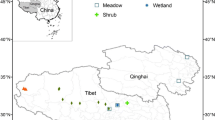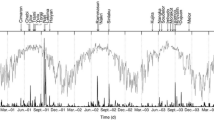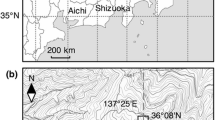Abstract
Seasonal variation of dissolved organic C (DOC) and its effects on microbial activity and N dynamics were studied during two consecutive years in soils with different organic C concentrations (hilltop and hillslope) in a tropical deciduous forest of Mexico. We found that DOC concentrations were higher at the hilltop than at the hillslope soils, and in both soils generally decreased from the dry to the rainy season during the two study years. Microbial biomass and potential C mineralization rates, as well as dissolved organic N (DON) and NH +4 concentrations and net N immobilization were higher in soils with higher DOC than in soils with lower DOC. In contrast, net N immobilization and NH +4 concentration were depleted in the soil with lowest DOC, whereas NO −3 concentrations and net nitrification increased. Negative correlations between net nitrification and DOC concentration suggested that NH +4 was transformed to NO −3 by nitrifiers when the C availability was depleted. Taken together, our results suggest that available C appears to control soil microbial activity and N dynamics, and that microbial N immobilization is facilitated by active heterotrophic microorganisms stimulated by high C availability. Soil autotrophic nitrification is magnified by decreases in C availability for heterotrophic microbial activity. This study provides an experimental data set that supports the conceptual model to show and highlight that microbial dynamics and N transformations could be functionally coupled with DOC availability in the tropical deciduous forest soils.




Similar content being viewed by others
Abbreviations
- DOC:
-
Dissolved organic carbon
- DON:
-
Dissolved organic nitrogen
References
Asmar F, Eiland F, Nielse NE (1994) Effect of extracellular-enzyme activities on solubilization rate of soil organic nitrogen. Biol Fertil Soils 17:32–38
Balvanera P, Lott E, Segura G, Siebe Ch, Islas A (2002) Patterns of beta-diversity in a Mexican tropical dry forest. J Veget Sci 13:145–158
Barrett JE, Burke IC (2000) Potential nitrogen immobilization in grassland soils across a soil organic matter gradient. Soil Biol Biochem 32:1707–1716
Bernhardt ES, Likens G (2002) Dissolved organic carbon enrichment alters nitrogen dynamics in a forest stream. Ecology 83:1689–1700
Booth MS, Stark JM, Rastetter E (2005) Controls on nitrogen cycling in terrestrial ecosystems: a synthetic analysis of literature data. Ecology 75:139–157
Brookes P, Landman A, Pruden G, Jenkinson D (1985) Chloroform fumigation and the release of soil nitrogen: a rapid direct extraction method to measure microbial biomass nitrogen in soil. Soil Biol Biochem 17:837–842
Campo J, Maass JM, de Pablo L (2001) Intemperismo en un bosque tropical seco de México. Agrociencia 35:245–254
Chantigny MH (2003) Dissolved and water-extractable organic matter in soils: a review on the influence of land use and management practices. Geoderma 113:357–380
Chapin 3rd FS, Matson PA, Mooney HA (2002) Principles of terrestrial ecosystem ecology. Springer, Berlin Heidelberg-New York, USA, p. 436
Chen J, Stark JM (2000) Plant species effects and carbon and nitrogen cycling in a sagebrush-crested wheatgrass soil. Soil Biol Biochem 32:47–57
Cotler H, Durán E, Siebe Ch (2002) Caracterización morfo-edafológica y calidad de sitio de un bosque tropical caducifolio. In: Noguera FA, Vega JH, García A, Quezada M (eds) Historia Natural de Chamela. Instituto de Biología, UNAM, Mexico City, pp. 17–79
Davidson EA, Kingerlee W (1997) A global inventory of nitric oxide emissions from soils. Nutr Cycl Agroecosyst 48:37–50
Galicia L, García-Oliva F, López-Blanco J (1995) Efecto de la estructura jerárquica del relieve en la distribución de las características físicas de los suelos en una cuenca tropical estacional mexicana. Bol Invest Geográficas 13:53–75
Galicia L, López-Blanco J, Zarco-Arista AE, Filips V, García-Oliva F (1999) The relationship between solar radiation interception and soil water content in a tropical deciduous forest in Mexico. Catena 36:153–164
García-Méndez G, Maass JM, Matson P, Vitousek P (1991) Nitrogen transformations and nitrous oxide flux in a tropical deciduous forest in Mexico. Oecologia 88:362–366
García-Oliva F, Camu A, Maass JM (2002) El clima de la Región de Central de la costa del Pacífico Mexicano. In: Noguera FA, Vega JH, García A, Quezada M (eds) Historia Natural de Chamela. Instituto de Biología, UNAM, Mexico City, pp. 3–10
García-Oliva F, Ezcurra E, Galicia L (1991) Pattern of rainfall distribution in the Central Pacific coast of Mexico. Geografiska Annaler 73:179–186
García-Oliva F, Gallardo JF, Montaño NM, Islas P (2006) Soil carbon and nitrogen dynamics followed by a forest-to-pasture conversion in western Mexico. Agroforestry Syst 66:93–100
García-Oliva F, Maass JM (1998) Efecto de la transformación de la selva a pradera sobre la dinámica de los nutrientes en un ecosistema tropical estacional en México. Bol Soc Bot Mex 62:39–48
García-Oliva F, Martínez-Lugo R, Maass JM (1995) Long-term net soil erosion as determined by 137Cs redistribution in an undisturbed and perturbed tropical deciduous forest ecosystem. Geoderma 68:135–147
García-Oliva F, Sveshtarova B, Oliva M (2003) Seasonal effect on soil organic carbon dynamic in a tropical deciduous forest ecosystem in western Mexico. J Trop Ecol 19:1–11
Hadas A, Sofer M, Molina JE, Barak P, Clapp CE (1992) Assimilation of nitrogen by soil microbial population: NH4 versus organic N. Soil Biol Biochem 24:137–143
Hart S, Nason GE, Myrolod D, Perry DA (1994) Dynamics of gross nitrogen transformations in an old-growth forest: the carbon connection. Ecology 75:880–891
Jansson SL (1958) Tracer studies on nitrogen transformation in soil with special attention to mineralization-immobilization relationships. Ann Royal Agric Coll Sw 24:101–361
Jaramillo VJ, Sanford Jr RL (1995) Nutrient cycling in tropical deciduous forest. In: Bullock SH, Mooney HA, Medina E (eds) Seasonally dry tropical forest. University Press, Cambridge, pp. 346–361
Jha PB, Singh JS, Kashyap AK (1996) Dynamics of viable nitrifier community and nutrient availability in dry tropical forest habitat as affected by cultivation and soil texture. Plant Soil 180:277–285
Joergensen RG (1996) The fumigation-extraction method to estimate soil microbial biomass: calibration of the k EC value. Soil Biol Biochem 28:25–31
Joergensen RG, Mueller T (1996) The fumigation-extraction method to estimate soil microbial biomass: calibration of the k EN value. Soil Biol Biochem 28:33–37
Jones DL, Healey JR, Willett VB, Farrar JF, Hodge A (2005) Dissolved organic nitrogen uptake by plants an important N uptake pathway? Soil Biol Biochem 37:413–423
Jones DL, Willett VB (2006) Experimental evaluation of methods to quantify dissolved organic nitrogen (DON) and dissolved organic carbon (DOC) in soil. Soil Biol Biochem 38:991–999
Kummerow J, Castellanos J, Maass JM, Larigauderie A (1990) Production of fine roots and the seasonality of their growth in a Mexican tropical dry forest. Vegetatio 90:73–80
Lodge DJ, Mcdowell WH, McSwiney CP (1994) The importance of nutrient pulses in tropical forests. Trends Ecol Evol 9:384–387
López-Blanco J, Galicia L, García-Oliva F (1999) Hierarchical analysis of relief features in a small watershed in a tropical deciduous forest ecosystem in Mexico. Suppl Geogrf Fis Dinam Quat 22:33–40
Lott EJ (1993) Annotated checklist of the vascular flora of the Chamela Bay region, Jalisco, Mexico. Occ Papers Calif Acad Sci 148:1–60
Luizao RC, Bonde TA, Rosswall T (1992) Seasonal variation of soil microbial biomass. The effects of clearfelling or tropical rainforest and establishment of pasture in the Central Amazon. Soil Biol Biochem 8:805–813
Maass JM, Jaramillo VJ, Martínez-Yrízar A, García-Oliva F, Pérez-Jiménez A, Sarukhán J (2002) Aspectos funcionales del ecosistema de la selva baja caducifolia en Chamela, Jalisco. In: Noguera FA, Vega JH, García A, Quezada M (eds) Historia Natural de Chamela. Instituto de Biología, UNAM, Mexico City, pp. 525–551
Martínez-Yrízar A (1995) Biomass distribution and primary productivity of tropical dry forest. In: Bullock SH, Mooney HA, Medina E (eds) Seasonally dry tropical forest. University Press, Cambridge, pp. 327–345
Martínez-Yrízar A, Maass JM, Pérez-Jiménez A, Sarukhán J (1996) Net primary productivity of a tropical deciduous forest ecosystem in western Mexico. J Trop Ecol 12:169–175
Neff JC, Asner GP (2001) Dissolved organic carbon in terrestrial ecosystems: synthesis and a model. Ecosystems 4:29–48
Paul EA, Clark FE (1989) Soil microbiology and biochemistry. Academic Press, San Diego, Calif, p. 273
Raghubanshi AS (1992) Effect of topography on selected soil properties and nitrogen mineralization in a dry tropical forest. Soil Biol Biochem 24:145–150
Robertson PG, Coleman DC, Bledsoe CS, Sollins P (1999) Standard soil methods for long-term ecological research (LTER). University Press, Oxford, New York, pp. 258–271
Roy S, Singh JS (1995) Seasonal and spatial dynamics of plant-available N and P pools and N-mineralization in relation to fine roots in a dry tropical forest habitat. Soil Biol Biochem 27:33–40
Saynes V, Hidalgo C, Etchevers J, Campo J (2005) Soil C and N dynamics in primary and secondary seasonally dry tropical forests in Mexico. Appl Soil Ecol 29:282–289
Schimel JP, Bennett J (2004) Nitrogen mineralization: challenges of a changing paradigm. Ecology 85:591–602
Schimel JP, Weintraub MN (2003) The implications of exoenzyme activity on microbial C and N limitation in soil: a theoretical model. Soil Biol Biochem 35:549–563
Singh JS, Kashyap AK (2006) Dynamics of viable nitrifier community, N mineralization and nitrification in seasonally dry tropical forests and savanna. Microbiol Res 161:169–179
Singh JS, Raghubanshi AS, Singh RS, Srivastava SC (1989) Microbial biomass acts as a source of plant nutrients in dry tropical forest and savanna. Nature 338:499–500
Sokal RR, Rohlf FJ (1995) Bometry. Freeman and Company, San Francisco, Calif, p. 832
Solís E (1993) Características fisicoquímicas de un suelo en un ecosistema tropical estacional Bs. Thesis, Universidad Nacional Autónoma de México, México City, Mexico, p 91
Srivastava SC (1992) Microbial C, N and P in dry tropical soils: seasonal changes and influence of soil moisture. Soil Biol Biochem 24:711–714
StatSoft (2000) Statistica ver. 6.0. for Windows [Computer program manual]. Tulsa, OK
Strauss EA, Lamberti G (2002) Effect of dissolved organic carbon quality on microbial decomposition and nitrification rates in stream sediments. Freshw Biol 47:65–74
Technicon (1977) Technicon industrial System. Method No. 329–74W/B Individual/simultaneous determinations of nitrogen and/or phosphorus in BD acid digest. Technicon Industrial Systems, New York
UIC (1995) Operation manual for the CM5012 CO2 Colourmeter. UIC Joliet IL, USA
Vance ED, Brookes AC, Jenkinson DS (1987) An extraction method for measuring soil microbial biomass C. Soil Biol Biochem 19:703–707
Verhagen FJ, Laanbroek HJ (1991) Competition for ammonium between nitrifying and heterotrophic bacteria in dual energy-limited chemostats. App Environ Microbiol 57:3255–3263
Vitousek P, Matson PM (1988) Nitrogen transformations in a range of tropical forest soils. Soil Biol Biochem 20:361–367
Vitousek P, Matson PM, Volkmann C, Maass JM, García-Méndez G (1989) Nitrous oxide flux from dry tropical forests. Global Biogeochem Cycles 3:375–382
von Ende CN (1993) Repeated measures analysis: growth and other time-dependent measures. In: Scheiner SM, Gurevitch J (eds) Design and analysis of ecological experiments. Chapman and Hall, New York, USA, pp. 113–137
Wardle DA (1992) A comparative assessment of the factors which influence microbial biomass carbon and nitrogen levels in soil. Biol Rev 67:321–358
Acknowledgements
We thank Edmundo García-Moya for useful and constructive comments on this project. We would like to thank Maribel Nava-Mendoza for her technical support with chemical analyses in the laboratory. We are also grateful to Salvador Araiza, Abel Verduzco, Carlos Anaya and Ana Noguez for their help in the field work, and Enrique Tapia for his support in the laboratory. We thank Raúl Ahedo, Heberto Ferreira and Alberto Valencia for assistance in data processing, and the personnel of the Chamela Biological Station of the Institute of Biology, Universidad Nacional Autónoma de México (UNAM) for logistic support during field work. We also thank the critical comments of two anonymous reviewers, who helped us to considerably improve the manuscript for publication. N.M. Montaño acknowledges Consejo Nacional de Ciencia y Tecnología (CONACyT)-Mexico (No. 163199) and Dirección General de Estudios de Posgrado (DGEP)-UNAM for scholarships to pursue a doctoral degree in the Centro de Investigaciones en Ecosistemas, UNAM, Mexico. This project was supported by CONACyT-Mexico (G27674-N).
Author information
Authors and Affiliations
Corresponding author
Additional information
Responsible Editor: Chris Neill
Rights and permissions
About this article
Cite this article
Montaño, N.M., García-Oliva, F. & Jaramillo, V.J. Dissolved organic carbon affects soil microbial activity and nitrogen dynamics in a Mexican tropical deciduous forest. Plant Soil 295, 265–277 (2007). https://doi.org/10.1007/s11104-007-9281-x
Received:
Accepted:
Published:
Issue Date:
DOI: https://doi.org/10.1007/s11104-007-9281-x




